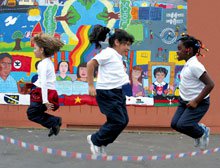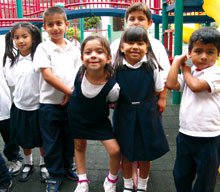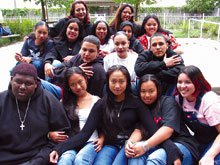Recess Struggles: Students Help Teachers Maintain a Peaceful Playground
At lunchtime recess on elementary school playgrounds, ball fields, and schoolyards across the nation, the joyful sounds of children at play are often interrupted by shouts of distress: "She took my basketball!" "He cut ahead of me!" "It's my turn!" "You cheated!" "Stop pushing!"

Most of the time, these are familiar and common exclamations from children learning to deal with conflict and trying to get along with each other. Occasionally, however, pushing leads to fighting, or name-calling becomes painful harassment. At its worst, children are bruised and hurt physically and/or emotionally.
Administrators, teachers, parents, and lunch aides work tirelessly to resolve each encounter or crisis for the well-being and safety of children. Although we try to offer sound advice, we do it through grown-up eyes, always looking at the conflict or issue through the lens of the adult world. As much as we try, we cannot truly see nor feel the children's perspective. Our solutions to their daily lunchtime trials often fail to satisfy them or simply seem unfair. We mean well and apply an array of creative, well-researched, and common sense strategies. Still, we struggle each day to help children avoid and solve conflict.
Have you had a similar experience? How did you respond to the recess struggles? Before I retired recently as principal, I partnered with one my colleagues, the principal of the elementary school a block away from my middle school, on an elementary school/middle school peer-mediator project. Given the distress calls, we turned to the children to help us.
At the elementary school, teams of fourth and fifth graders (typically groups of three or four) assisted the adults in mediating lunchtime conflicts among the first, second, and third graders. The hope was that the older children, with their primary-grade experiences still relatively fresh in their minds, would be able to recognize and understand the issues facing their younger schoolmates. They observed the children at play and intervened as conflicts arose.

Based, in part, on the Open Circle training they had received in classes throughout the year, they offered advice and strategies to the primary-grade children and monitored the effectiveness of their suggestions. Open Circle, a social- and emotional-learning program developed at the Stone Center, at Massachusett's Wellesley College, gives the children an awareness of key concepts, terminology, and strategies in the area of conflict resolution.
While the fourth and fifth graders had the advantage of recent primary-grade experiences as well as Open Circle training, their knowledge of intervention strategies and their ability to mediate conflict were still relatively limited. Help came from the seventh and eighth graders at my middle school, who willingly and eagerly offered their assistance. They brought to the peer mediator/mentor model increased knowledge and broader experience.
In addition to their Open Circle experience in elementary school, they received instruction in social and emotional learning and conflict resolution. The fundamental task for the seventh and eighth graders was to observe and assess the interventions of the fourth and fifth graders, not necessarily the behavior of the primary-grade children.
They helped them to more comprehensively recognize and define manifestations of conflict on the playground and to identify and implement a range of conflict resolution strategies. Since social and emotional learning is fundamental to the cultures of both the elementary school and the middle school, the children used familiar and common concepts, terminology, and strategies as they mediated and mentored.
Implementation of the peer-mediator/mentor model began with the teachers identifying the children who either volunteered or were invited to serve as mediators and mentors. Typically, forty-eight children (half from each school) participated in the project. The principals and the children gathered for a morning breakfast meeting at the middle school; that was a very special treat for the elementary school children. The agenda was an exciting and challenging one that asked the children to
- introduce themselves
- identify the purposes and goals of the project
- organize teams of fourth- and fifth-grade mediators and seventh- and eighth-grade mentors
- list potential issues and situations that might arise on the playground
- brainstorm the range of possible approaches, strategies, and solutions that might prevent or solve conflict
- create a schedule of seventh- and eighth-grader visits to the elementary school
Following the initial meeting, the student mediators and mentors began their collaboration. Each day, rotating teams of fourth and fifth graders observed the first, second, and third graders in action on the playground. They observed the children at play, looking for instances of potential disagreement and conflict. As needed, they intervened by offering a variety of conflict-resolution strategies. They applied their knowledge and skill as they spoke with the younger children in hopes of resolving the issues. Naturally, they were instructed to seek the aid of an adult in the event of a dangerous or serious incident.
The elementary school mediators were joined each day by one of the mentoring teams from the middle school. Similar to their elementary school classmates, they used a rotating cycle of team visits. As mentors (not mediators), their purpose was to offer suggestions to the fourth and fifth graders regarding alternative strategies for mediating conflict.
Their challenge was to help the elementary school mediators reflect upon the strategies they recommended and consider a variety of options. They helped them assess the effectiveness of their mediation efforts. The daily exchange of insights, perspectives, and suggestions among the fourth, fifth, seventh, and eighth graders was a powerful process of peer collaboration.
The middle school mentors maintained a daily journal of their observations and suggestions. The journal became a primary source document at the monthly meetings of all of the mediators and mentors, and the entries served as the basis for reviewing and analyzing each day's activities.

The periodic meetings provided an opportunity for the children to share their experiences, assess the effectiveness of their interventions, and continue to explore meaningful conflict-resolution strategies. Similar to the conversations on the playground between mediators and mentors, the discussions at the periodic meetings enhanced and reinforced the children's ability to work cooperatively in a supportive problem-solving and learning environment.
As a result of the daily interaction, the fourth, fifth, seventh, and eighth graders built a sense of trust, respect, and common purpose. The hope was that through their joint efforts they would help the younger children learn to play together more joyfully and cooperatively. At the same time, the fourth and fifth graders would develop mediation skills and conflict-resolution strategies that helped them as they learned and grew. In turn, the seventh and eighth graders acquired and demonstrated leadership skills as well as the ability to apply conflict-resolution techniques and strategies at the middle school.
The desired outcome of the peer-mediator/mentor model was to enable elementary school and middle school children to become partners in a comprehensive effort to create a safe and supportive learning environment in which all children benefited. Although the model was intended to help address playground issues at the first, second, and third grades, it can be replicated at other grade levels for a variety of purposes.
The model reinforced many of the most essential aspects of the elementary school and middle school programs. It was a project-based and reality-based learning experience for children, it offered opportunities for authentic assessment and cooperative learning, it enhanced self-esteem and built self-confidence, and it challenged children to think critically by identifying and solving problems. Hopefully, the most meaningful, long-term benefit of the peer-mediator/mentor model was the nurturing of a caring and supportive social- and emotional-learning environment for all elementary school and middle school children.